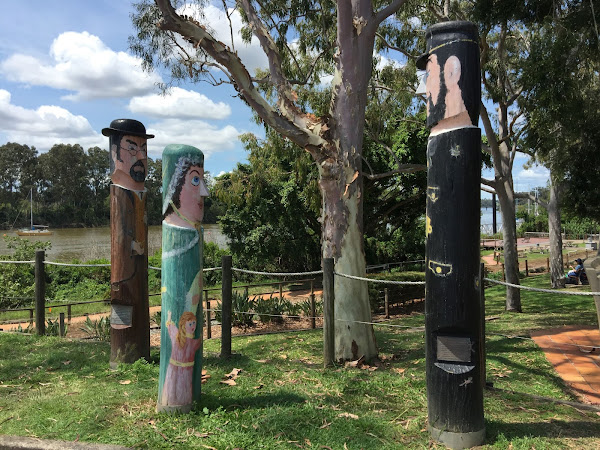We had a short 9 day trip in our caravan, as we were going to see Michael Waugh in Nambour. We stayed the first night in Bli Bli Caravan Park - we will go back there - and then 4 nights at Inskip Point so Peter could fish and we could walk along the beach and relax. We stayed at Donna Villa SC RV Park @$10 per night. It is located next to the airport and we didn't have any noise issues.
Queens Park is a place we always visit when we are in Maryborough. Queens Park is a heritage site and was once a cattle and sheep boiling-down works c1849. Later in 1859, sawpits milled the giant kauri pines in the area. The park was set aside as a botanical garden in October 1873, and the first trees were planted in 1874. It was added to the Queensland Heritage Register in October 1922. We parked near the Duncan Chapman Statue.
In 2015 as part of the Centenary of the Gallipoli landing during WWI, a life-size bronze statue of Lieutenant Duncan Chapman was unveiled at the dawn service. Chapman was the first man to step on shore at Gallipoli on 25 April 1915, as part of the 45th Battalion.
He was born in Maryborough in 1888, and was killed in action at Pozieres, Somme, France in 1916. This is the best war memorial we have seen. We went back at night to see it all lit up.
In the floods earlier this year (2022) the Courier Mail has a photo that shows the statue like Duncan is walking from the boats to the beach - through the water. Google Duncan Chapman Memorial in flood. There is a lovely walkway that has the story of the ANZACS behind the statue.
Further along the park is a walkway that as you pass small boxes along the way the story of war is broadcast to hear. Unfortunately some of the audio didn't work, probably due to the earlier floods this year.
 Walking along the path are metal displays to depict items used during the war years.
Walking along the path are metal displays to depict items used during the war years.The Maryborough War Memorial was built to commemorate those who died in WWI. In 1920 a committee was formed and the foundation stone was laid on 22 May 1921. The obelisk is topped by a winged figure symbolising Victory. The entrance gates are located at the rear of the obelisk and comprise of two swinging wrought iron gates of British gun metal. On either side are sandstone pillars. Originally there were two sets of gates however the other gates were removed. The remaining gates were added to the Queensland Heritage Register in 2014. The memorial has since had additional plaques to commemorate those killed in other wars.
Near the gates is a large unusual tree with long seed pods resembling sausages. It is called a Sausage Tree. 😀 Never seen one like it before.
The park is lovely to walk through. It is a great place to take a picnic lunch, although there are a few lovely cafes near by.
The Band Rotunda built in 1890 and was the shelter over a fountain. It is listed by the National Trust. The fountain and rotunda was built by Miss Jane Melville in memory of her brother Andrew, who was mayor of Maryborough in 1863. The rotunda and the fairy fountain were imported from Scotland in 1890. In 1905 the fountain was moved from under the rotunda to where it is now.
The last Sunday of each month their are activities in the park with live bands performing in the rotunda and miniature steam train rides around the park.
There
is a Gauge Model Railway built by the Model Engineers and Live
Steamers. On the last Sunday of each month the Maryborough Brass Band
plays in the rotunda, and the model stream train runs. The Fairy Fountain can be seen behind the station.
The gift of the Naval authorities of two guns in 1914 stand overlooking the Mary River.
The large gun is a 5" Armstrong Mark IV, 50 pounder breech loading gun that was sent from Cooktown to Maryborough about 1910. One of the smaller ones is a single barrel Nordenfelt 2.8 pounder breech loading gun originally on the Gayundah. The other smaller gun is a two barrel one inch Nordenfelt gun originally from the Midge. Both small guns were sent to Maryborough about 1911 to be used as training weapons by the Maryborough Naval Brigade. By 1914 the guns were no longer needed and they were offered to the council for public display in Queens Park.

The second is the South Sea Islanders in Maryborough sculpture. In 1863 indentured labour was introduced into Queensland and in 1867 the first indentured labour vessel, 'Mary Smith' arrived in Maryborough with 84 South Seas Islanders. It is a sad story of ill treatment and bad working conditions. The black marble boulders are from Chillagoe, where there was once an inland sea. The sea that eroded the boulders also lapped the shores of the islands. The splitting of boulders signifies the lives and families that were split. The symbols on the were on the stones were chosen by the descendants and are made of bronze. They are placed in the heart of the stones.
Continuing the Military Trail in Queens Park down to the port where the boat building once took place. Every where is sign posted with the history and significance.
This is where the rail tracks end in the park.
One can easily spend a day here walking around the park, having lunch or tea in one of the cafes or pubs, or even a picnic in the park.


































What a marvelous park, and such interesting Anzac memorials. Its wonderful that the first man to step ashore is so honoured. I've never seen or heard of a sausage tree either!
ReplyDelete